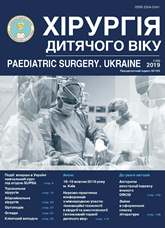Surgical stabilization of the chest: experience and perspectives
DOI:
https://doi.org/10.15574/PS.2019.63.18Keywords:
blunt chest trauma, rib fractures, surgical treatmentAbstract
The article gives an overview of the long-term use of osteosynthesis of ribs by wires and plates for the surgical stabilization of the chest wall during injury. It has been established that the use of this method has the features of a complex approach; the main term of application is delayed (89.1% of cases). It is possible to achieve good direct results in 91.9%; the level of postoperative complications is 6.8%. Stabilization of rib fractures is an absolutely necessary procedure for rendering assistance to victims of fractures of the ribs and sternum. The choice of the method of surgical stabilization depends on the patient’s condition, the experience of the clinic and/or surgeon, the source of funding.References
Wagner EA. (1969). Closed injury of chest of peacetime. Moscow: Medicine: 300.
Glomcher FS, Fomin PD, Pedachenko EG et al. (2012). Polytrauma: surgery, traumatology, anesthesiology, intensive care: a manual. Kyiv: VSI Medicine: 735.
Melnyk VM, Opanasenko MS, Tereshkovich OV et al. (2015). Diagnosis and treatment of chest trauma: a methodical manual for doctors. Kyiv: 27.
Panasenko SI, Kovalchuk SB, Guriev SO et al. (2017). Biomechanical characteristics of individual methods of osteosynthesis of ribs. Trawma. 18; 2: 122–127. https://doi.org/10.22141/1608-1706.2.18.2017.102570
Pertsov VI, Telushko YaV. (2008). The method of surgical treatment of numerous and segmental fractures of ribs: the register. No. 336/29/08. Register of sectoral innovations. 28–29: 222.
Avery EE, March ET, Benson DW. (1956). Critically crushed chest: a new method of treatment with continuous mechanical hyperventilation to produce alkalotic apnea and internal pneumatiс stabilization. J Thoracic Surg. 32: 291–311.
Bemelman M, Blokhuis TJ, Leenen LPH. (2010). Historic overview of treatment techniques for rib fractures and flail chest. Eur J Emerg Surg. 36(5): 407–415. https://doi.org/10.1007/s00068-010-0046-5; PMid:21841952 PMCid:PMC3150827
Burstrom K, Sun S, Gerdtham UG еt al. (2014). Swedish experience-based value sets for EQ-5D health states. Qual Life Res. 23;2: 431–442. https://doi.org/10.1007/s11136-013-0496-4; PMid:23975375 PMCid:PMC3967073
Caragounis E, Olsen MF, Pazooki D еt al. (2016). Surgical treatment of multiple rib fractures and flail chest in trauma: a one-year follow-up study. World Journal of Emergency Surgery. 11: 27–33. https://doi.org/10.1186/s13017-016-0085-2; PMid:27307787 PMCid:PMC4908779
Сohen EA. (1955). Treatment of the flail chest by towel clip traction. Am J Surg. 90: 517–521. https://doi.org/10.1016/0002-9610(55)90790-X
De Buck F, Devroe S, Missant C еt al. (2012). Regional anesthesia outside the operating room: indications and techniques. Curr Opin Anaesthesiol. 25; 4: 501–507. https://doi.org/10.1097/ACO.0b013e3283556f58; PMid:22673788
Fabricant L, Ham B, Mullins R еt al. (2013). Prolonged pain and disability are common after rib fractures. Am J Surg. 205; 5: 511–515. https://doi.org/10.1016/j.amjsurg.2012.12.007; PMid:23592156
Granetzny A, Abd M, Emam E, Shalaby A, Boseila A. (2005). Surgical versus conservative treatment of flail chest. Evaluation of the pulmonary status. Interact. Cardiovasc. Thorac. Surg. 4; 6: 583–587. https://doi.org/10.1510/icvts.2005.111807; PMid:17670487
Hudson TR, Mc Elvenny RT, Head JR. (1954). Chest wall stabilization by softtissue traction: a new method. JAMA. 156: 768–769. https://doi.org/10.1001/jama.1954.02950080016007; PMid:13201399
Kyriss T, Lenz U, Friedel G. (2016). Functional Outcome after Chest Wall Stabilisation. Zentralbl Chir. 141; 1: 6–11. https://doi.org/10.1055/s-0042-111327; PMid:27607891
Marasco SF, Davies AR, Cooper J et al. (2013). Prospective randomized controlled trial of operative rib fixation in traumatic flail chest. Am Coll Surg. 216; 5: 924–932. https://doi.org/10.1016/j.jamcollsurg.2012.12.024; PMid:23415550
Molnar TF. Surgical Management of Chest Wall Trauma. (2010). Thoracic Surgery Clinic. 20; 4: 475–485. https://doi.org/10.1016/j.thorsurg.2010.07.004; PMid:20974431
Downloads
Issue
Section
License
The policy of the Journal “PAEDIATRIC SURGERY. UKRAINE” is compatible with the vast majority of funders' of open access and self-archiving policies. The journal provides immediate open access route being convinced that everyone – not only scientists - can benefit from research results, and publishes articles exclusively under open access distribution, with a Creative Commons Attribution-Noncommercial 4.0 international license(СС BY-NC).
Authors transfer the copyright to the Journal “PAEDIATRIC SURGERY.UKRAINE” when the manuscript is accepted for publication. Authors declare that this manuscript has not been published nor is under simultaneous consideration for publication elsewhere. After publication, the articles become freely available on-line to the public.
Readers have the right to use, distribute, and reproduce articles in any medium, provided the articles and the journal are properly cited.
The use of published materials for commercial purposes is strongly prohibited.

